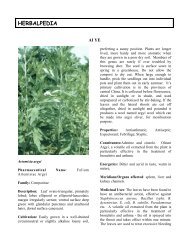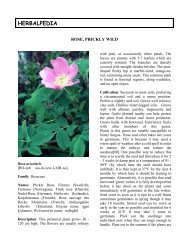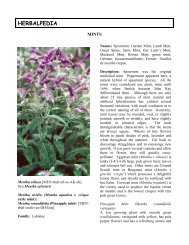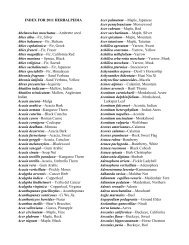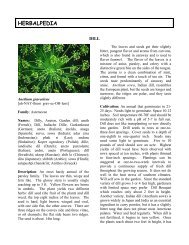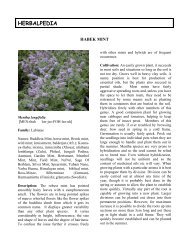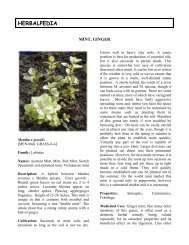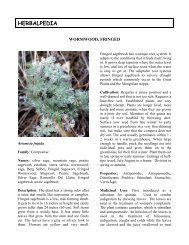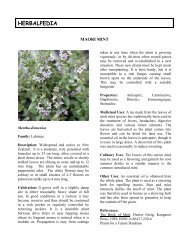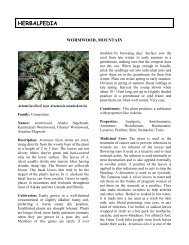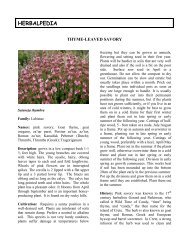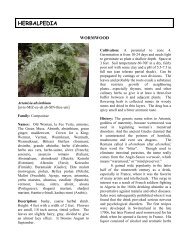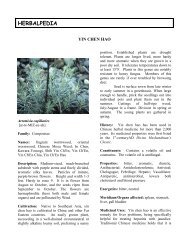Western Mugwort - Herbalpedia
Western Mugwort - Herbalpedia
Western Mugwort - Herbalpedia
You also want an ePaper? Increase the reach of your titles
YUMPU automatically turns print PDFs into web optimized ePapers that Google loves.
HERBALPEDIA<br />
MUGWORT, WESTERN<br />
the presence of fine hairs. The lance-shaped<br />
leaves are mostly about 1-3 inches long and can<br />
be entire, irregularly toothed, or lobed.<br />
Hundreds of tiny yellowish flower heads form<br />
on the upper branches. Fruits are tiny achenes<br />
with no bristles. It is hardy to zone 5. It is in<br />
flower from August to October, and the seeds<br />
ripen from September to October. The flowers<br />
are hermaphrodite and are pollinated by the<br />
wind.<br />
Artemisia ludoviciana<br />
[ar-te-MIZ-ee-uh loo-doh-vik-ee-AH-nuh]<br />
(syn Artemisia purshiana)<br />
Family: Compositae<br />
Names: western mugwort, Louisiana<br />
sagebrush, lobed cudweed, cudweed, pasture<br />
sage, Estafiate, Iztauhyatl, Altamiza, Ajenjo del<br />
Pais, Azumate, Estafiate, Louisiana Sagewort,<br />
White Sagebrush<br />
Description: White sage is a perennial from<br />
rhizomes (underground stems that root from the<br />
nodes). This aromatic plant may be over 3 feet<br />
tall. Stems and leaves are usually white from<br />
Cultivation: Drought tolerant. Easily grown<br />
in a well-drained circumneutral or slightly<br />
alkaline loamy soil, preferring a sunny position.<br />
Does well in a sandy soil. Established plants<br />
are very drought tolerant. Plants are longer<br />
lived, more hardy and more aromatic when<br />
they are grown in a poor dry soil. A very<br />
polymorphic species. Slugs love the young<br />
shoots of this plant and have been known to<br />
destroy even well-established plants. A very<br />
ornamental plant, spreading by stolons to form<br />
loose patches, it can be invasive. There are<br />
many named forms selected for their<br />
ornamental value. Members of this genus are<br />
rarely if ever troubled by browsing deer.<br />
Surface sow the seed from late winter to<br />
early summer in a greenhouse, making sure that<br />
the compost does not dry out. When large<br />
enough to handle, prick the seedlings out into<br />
individual pots and grow them on in the<br />
greenhouse for their first winter. Plant out in<br />
late spring or early summer. Division in spring<br />
or autumn. Basal cuttings in late spring.<br />
Harvest the young shoots when about10 - 15cm<br />
long, pot up in a lightly shaded position in a<br />
greenhouse or cold frame and plant them out<br />
when well rooted. Very easy.<br />
History: The name Louisiana sagebrush was<br />
given because the plant grows near St. Louis,
Missouri, although it is also found in Utah,<br />
Texas and Arizona.<br />
Properties: astringent<br />
Medicinal Uses: The leaves are astringent.<br />
They were commonly used by the Native<br />
Americans to induce sweating, curb pain and<br />
diarrhea. A weak tea was used in the treatment<br />
of stomach ache and menstrual disorders. Used<br />
by pregnant women to alleviate morning<br />
sickness. Externally, a wash of the leaves was<br />
applied to itching, rashes, swellings, boils,<br />
sores, etc. The wash was also applied to<br />
eczema and as an underarm deodorant. A<br />
poultice of the leaves can be applied to spider<br />
bites, blisters and burst boils. A snuff of the<br />
crushed leaves has been used to treat<br />
headaches, the sinuses and nosebleeds. The tea<br />
is added to bathwater is effective against<br />
arthritis. To soothe stomach ulcers, a tea is<br />
made by combining it with Manzanilla. A little<br />
is taken 3 times a day, cool or cold. A handful<br />
of the dried herb is added to a pot of barley<br />
simmering water and the steam inhaled through<br />
the open mouth, to treat lingering sore throats.<br />
Dosage: Cold infusion, 2-3 fluid ounces up to 4<br />
times a day.<br />
HERBALPEDIA is brought to you by The Herb Growing<br />
& Marketing Network, PO Box 245, Silver Spring, PA<br />
17575-0245; 717-393-3295; FAX: 717-393-9261; email:<br />
herbworld@aol.com URL: http://www.herbalpedia.com<br />
Editor: Maureen Rogers. Copyright 2006. All rights<br />
reserved. Material herein is derived from journals,<br />
textbooks, etc. THGMN cannot be held responsible for the<br />
validity of the information contained in any reference noted<br />
herein, for the misuse of information or any adverse effects<br />
by use of any stated material presented.<br />
Toxicity: Not appropriate during pregnancy or<br />
with overt liver disease.<br />
Culinary Uses: Leaves and flowering heads<br />
are used as a flavoring or garnish for sauces,<br />
gravies etc. A herb tea is made from the leaves<br />
and flowering heads.<br />
Other Uses: The leaves can be placed in the<br />
shoes as a foot deodorant. An infusion of the<br />
leaves has been used as an underarm deodorant.<br />
The soft leaves can be used as a toilet paper.<br />
The plant can be burnt to repel mosquitoes.<br />
incense, steam-bath<br />
References:<br />
Los Remedios, Michael Moore, Red Crane<br />
Press, 1990; ISBN: 1-878610-06-6<br />
Plants for a Future Database



